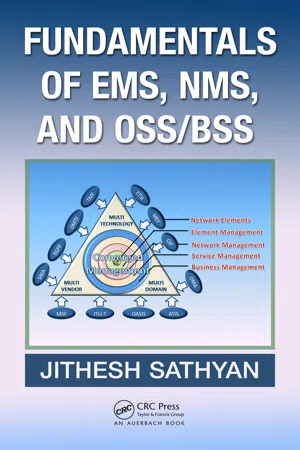
This is a test
- 588 pages
- English
- ePUB (mobile friendly)
- Available on iOS & Android
eBook - ePub
Fundamentals of EMS, NMS and OSS/BSS
Book details
Book preview
Table of contents
Citations
About This Book
In this era where data and voice services are available at a push of a button, service providers have virtually limitless options for reaching their customers with value-added services. The changes in services and underlying networks that this always-on culture creates make it essential for service providers to understand the evolving business logi
Frequently asked questions
At the moment all of our mobile-responsive ePub books are available to download via the app. Most of our PDFs are also available to download and we're working on making the final remaining ones downloadable now. Learn more here.
Both plans give you full access to the library and all of Perlego’s features. The only differences are the price and subscription period: With the annual plan you’ll save around 30% compared to 12 months on the monthly plan.
We are an online textbook subscription service, where you can get access to an entire online library for less than the price of a single book per month. With over 1 million books across 1000+ topics, we’ve got you covered! Learn more here.
Look out for the read-aloud symbol on your next book to see if you can listen to it. The read-aloud tool reads text aloud for you, highlighting the text as it is being read. You can pause it, speed it up and slow it down. Learn more here.
Yes, you can access Fundamentals of EMS, NMS and OSS/BSS by Jithesh Sathyan in PDF and/or ePUB format, as well as other popular books in Computer Science & Information Technology. We have over one million books available in our catalogue for you to explore.
Information
IV
IMPLEMENTATION GUIDELINES
Chapter 26
Socket Communication
This chapter is about the basics of network programming. It introduces the reader to the concept of writing client–server code. The client usually acts as the agent sourcing data to the server that listens for data from multiple clients. Out of the different techniques that are used for client–server programming, this chapter specifically deals with socket programming. Programming for TCP and UDP transport between client and server is also discussed.
26.1 Introduction
To complete this book on fundamentals of EMS, NMS, and OSS/BSS, it is essential to discuss the implementation basics for developing solutions using the concepts discussed in preceding chapters.
Some of the important aspects in developing management applications are:
- These applications mainly deal with the application layer. Management protocols usually lie in this layer.
- There will be multiple agents or clients running on the network elements that will collect data and send to a central server. Even for upper layers, there will be business and service level applications that take feed from multiple NMS clients.
- There are different techniques of communication based on environment. Socket-based programs, RPC-based programs, and web-based programs are quite common in implementing application interactions for management solutions.
- The specific application layer protocol is more a matter of choice based on data to be sent. For usual management operations like get, set, and trap functionalities, management protocols like SNMP or NETCONF could be used. While SNMP is the choice in most legacy solutions, the more recent applications use the power of XML and use XML-based protocols like SOAP. For other management functions like file transfer, FTP is still the most popular choice, and for alerts as mail SMTP is used.
This part of the book is intended to cover all these topics for developing management applications including a case study on the design approach to be ...
Table of contents
- Foreword
- Preface
- About the Author
- Section I - Element Management System (EMS)
- Section II - NETWORK MANAGEMENT SYSTEM (NMS)
- Section III - OPERATION/BUSINESS SUPPORT SYSTEMS (OSS/BSS)
- Section IV - IMPLEMENTATION GUIDELINES